The 1980s were not precisely Cadillac’s decade. While in the 1960s Cadillac, the creme de la creme of General Motors, could do no wrong, in the 1980s it seemed they made misstep after misstep. True, changes had to be made. Fuel economy had to be improved, dimensions reduced, and technology added. But there is no doubt that the first half of the decade was exceedingly painful at Cadillac Motor Division.
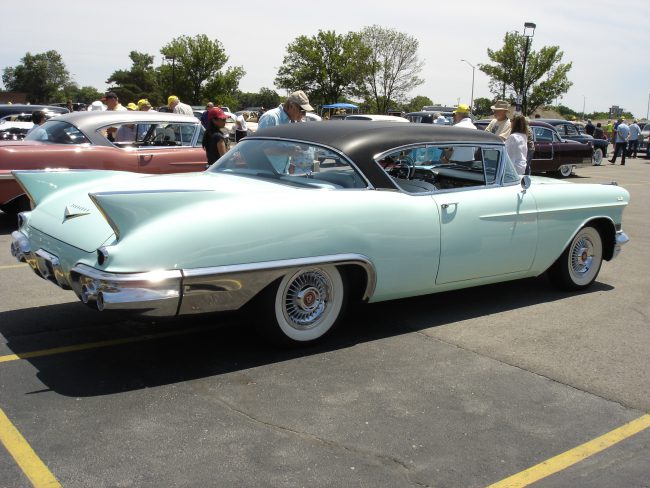
1957 Cadillac Eldorado Seville at the 2015 CLC Grand National, Brookfield, Wisconsin.
Cadillac could do no wrong in the ’50s and ’60s. They consistently outsold both Lincoln and Imperial and were essentially in a class of their own. But as the 1960s progressed into the early 1970s, they perhaps became a victim of their own success. The cars slowly became less special as Cadillac chased ever higher profits. Starting around 1969, Cadillac started skimping on interior materials.
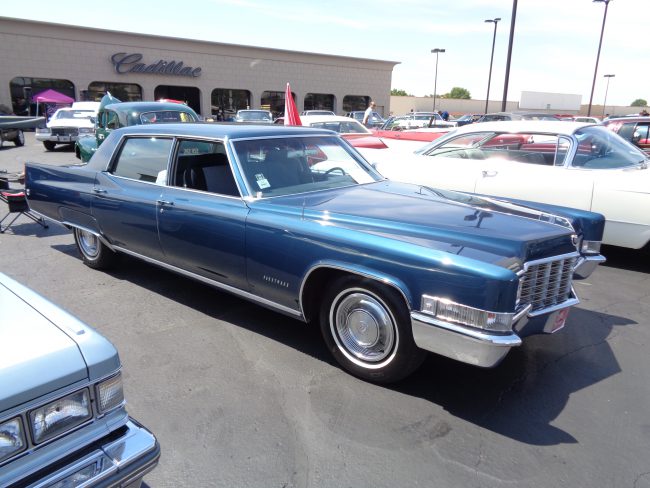
1969 Cadillac Fleetwood Sixty Special at the 2016 Heritage Cadillac show.
Not that the cars were bad. Hell no, they were still great cars. But there were some small things. What had been chrome plated hardware was replaced with flash-plated plastic. Real wood trim on the Fleetwoods was replaced with the soon-to-be ubiquitous wood-grained vinyl. Slowly but surely, Cadillacs had more in common with their B-body corporate cousins. While at the same time Chevrolets, especially the Caprice, became even more Cadillac-like.
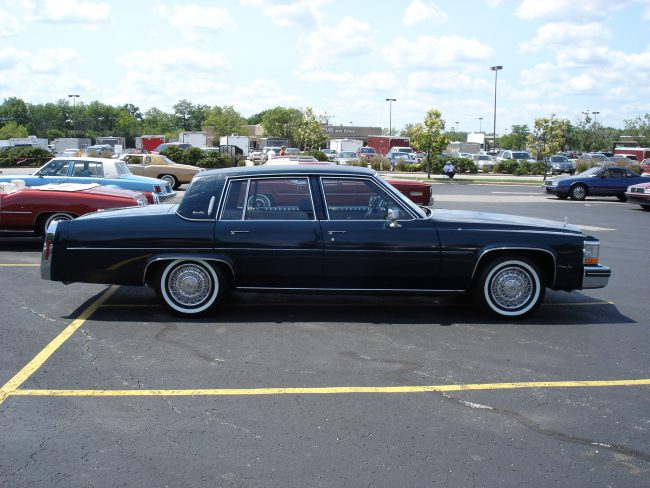
1980 Sedan de Ville at the 2015 CLC Grand National.
1980 would be the last time for several years that you could purchase a Cadillac and not worry about potential mechanical mayhem. The 368 CID V8 was robust and reliable, if somewhat detuned from the earlier 425. The new styling of the ’80 Cadillacs was quite attractive too, perhaps better than 1977-79.
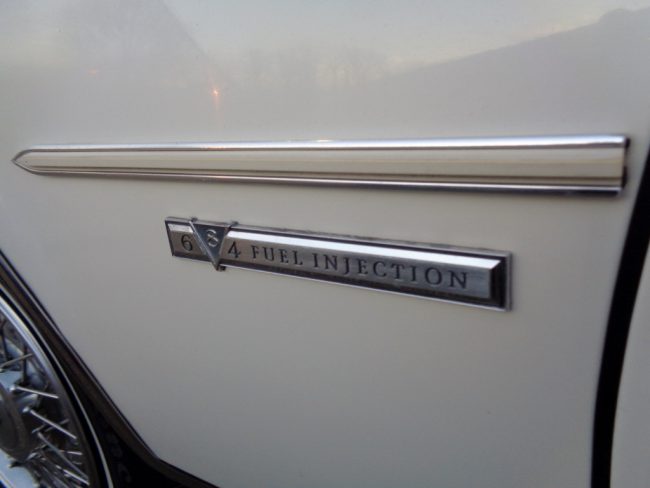
In 1981, the ill-fated V-8-6-4 was introduced. It was a good idea, but introduced just a bit before it was technologically robust for prime time. In the early ’80s the technology was in its infancy and the cylinder displacement module was nothing but trouble. It could be disconnected as simply as cutting a single wire, but the well-heeled folks who were buying new Cadillacs found such a solution unacceptable. The system should just work, or be able to be fixed and reliable. It wasn’t, and Cadillac’s reputation suffered.
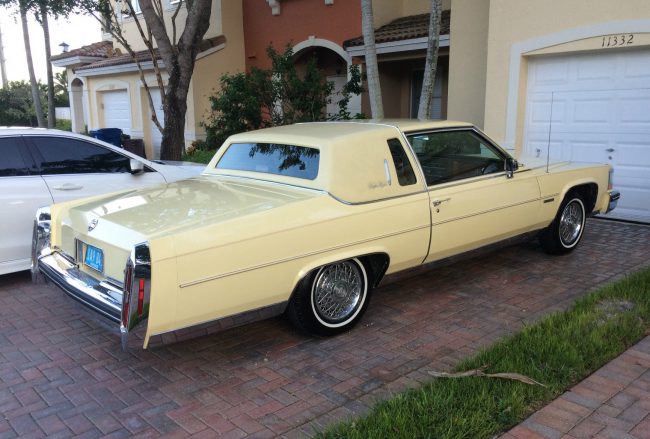
1982 Cadillac Fleetwood Brougham d’Elegance coupe
1982 brought a new engine. The aluminum block HT4100 “High Technology” 4.1L V8 was introduced that year, replacing the 368 in all Cadillac models save the limousines. It was in response to ever-tightening CAFE regulations, and it was not exactly the tough, powerful V8 Cadillac was known for. When it worked, it was slow for a V8 when you really stepped on it. But mechanical issues were common, at least in the early years.
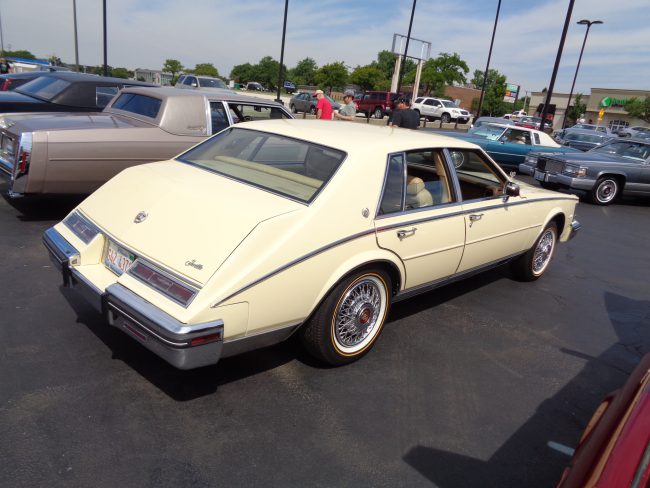
1985 Cadillac Seville at the 2016 Heritage Cadillac show. Stunning in Cameo Ivory!
But some were okay, as a friend of mine’s father-in-law had a 1984 Seville that lasted into the late ’90s on its original engine, racking up over 145,000 before it said uncle.
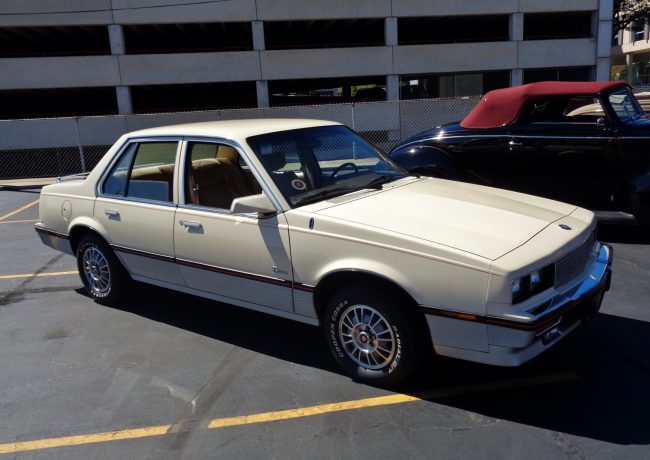
1985 Cadillac Cimarron
The ill-fated Cimarron, that favorite target of half-baked bloggers nationwide, also came out for ’82. Let’s save that car for another time! The 1982-1984 de Villes and Fleetwoods were not necessarily robust vehicles with their 4.1L ‘hand tighten’ engines, but at least they looked imposing and were clearly Cadillacs. That would change for 1985, when Sedan de Villes, Coupe de Villes and Fleetwoods went on a serious crash diet.
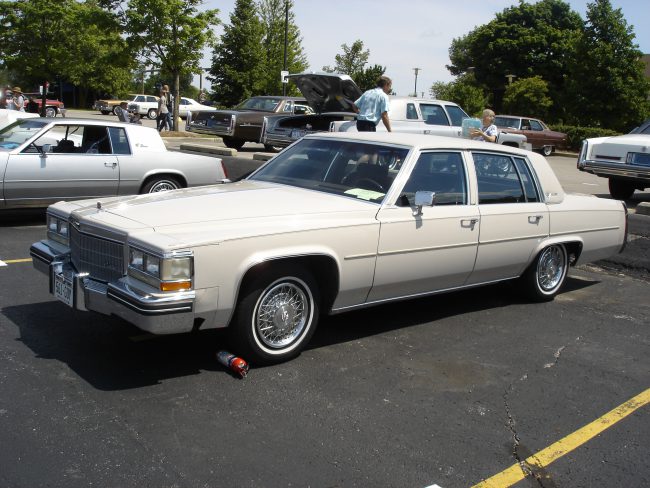
1984 Cadillac Sedan de Ville at the 2015 CLC Grand National.
Here is a 1984 Sedan de Ville. Still nice-looking, yes? Clearly a Cadillac, clearly a luxury car. You’d look great stepping out of it in front of the country club. But the look would be so much different in ’85!

1985 Fleetwood d’Elegance at the Chicago Auto Show. Photo: Jim Smith.
They were introduced as early ’85s in March of 1984 and although they had more space and were certainly more driver-oriented, some people (namely, people who never bought or owned or perhaps even drove a Cadillac) had a hard time taking them seriously as Cadillacs.
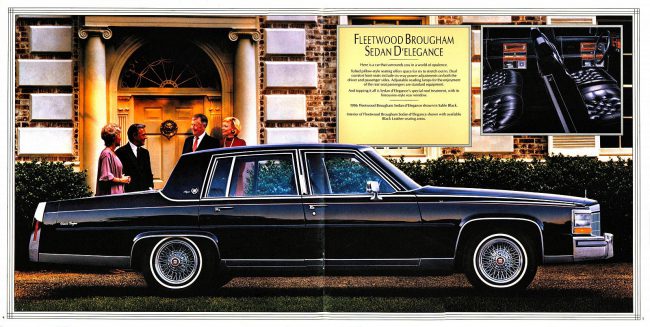
1986 Fleetwood Brougham. Still living large.
With the exception of the Fleetwood Brougham, which remained as before in all of its full-sized Broughaminess, all de Villes and Fleetwoods rode a much-reduced C-body platform, shared with the Buick Electra and Oldsmobile Ninety Eight. While the Cadillac retained its exclusive V8 (Electras and 98s made do with V6s), it wore the new design perhaps the least successfully.
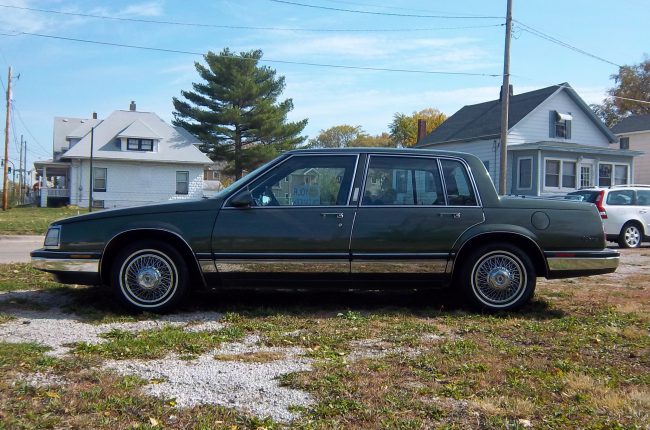
1985 Buick Electra Park Avenue
The Electra looked the best in my opinion, with the Olds in second place. They also had the benefit of the famous 3.8L V6, instead of the self-destructing Cadillac engine.
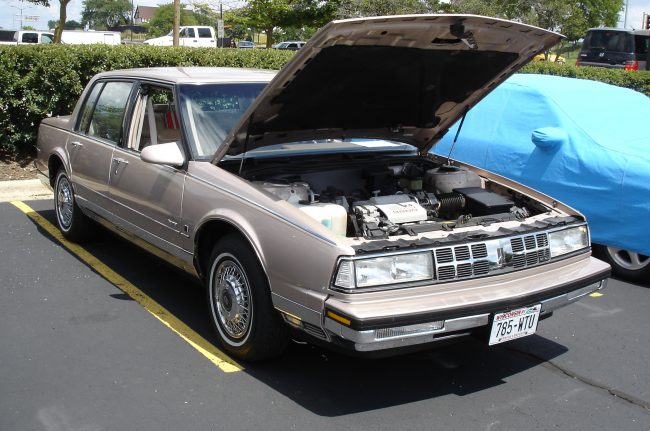
1990 Ninety-Eight Regency Brougham.
If you had to have a GM luxury car in 1985 the Buick and Olds were safer bets, and a truly full-size Delta 88, LeSabre, Parisienne or Caprice might have been an even better choice. But despite the drastic change of all three of the C-body GM luxury cars, they sold pretty well. Not everyone loved them like they loved the 1977-84 versions, but sales were respectable.
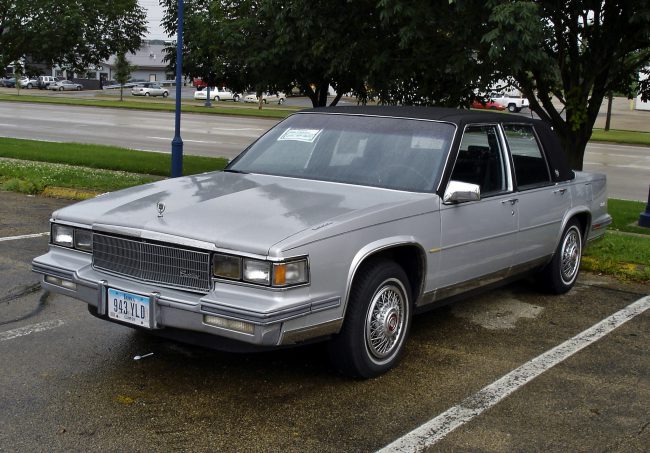
1985 de Villes and Fleetwoods were now front wheel drive with a transversely-mounted version of the 4.1L V8, with a 4.3L diesel V6 as a no-charge option (try and fine one of those today!). The 4.1 produced 130 hp at 4200 rpm and had 200 pund-feet of torque. Confusingly, Fleetwoods used the new body, while Fleetwood Broughams used the 1984 full-size platform. Yes, there were TWO Fleetwoods now, and they were very different from each other, though either one was suitably plush.
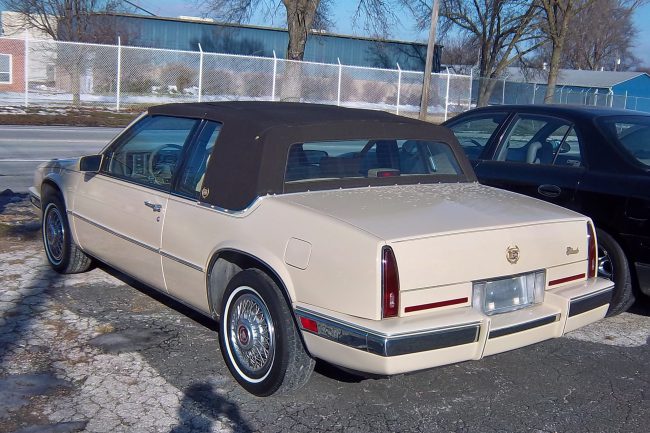
1986 Cadillac Eldorado
In GM’s defense, during the early ’80s most people thought gas prices were going to go through the roof. After the second gas crisis in 1979, gas was expected to hit $2 a gallon in a few years, so GM designers had to adapt Cadillac styling cues onto a much smaller platform. These shrunken Cadillacs were the result. The 1985 de Villes and Fleetwoods got respectable sales, though that would not exactly be the case when the even smaller Eldorado and Seville appeared in ’86. But that’s a story for another time.
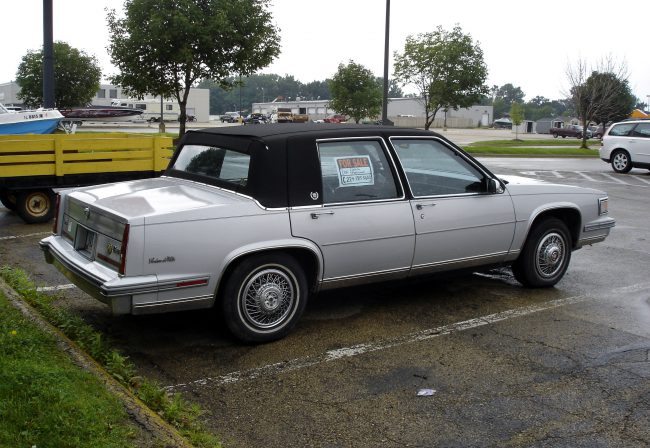
Not much changed for 1986. Coupe and Sedan de Villes received the wider chrome rocker moldings, as used on the ’85 Fleetwood. In addition, the bumper rub strips changed from black to dark gray, but that was about it visually. 1987 brought composite headlights, a new eggcrate grille, and slightly extended rear quarter panels with new taillights.
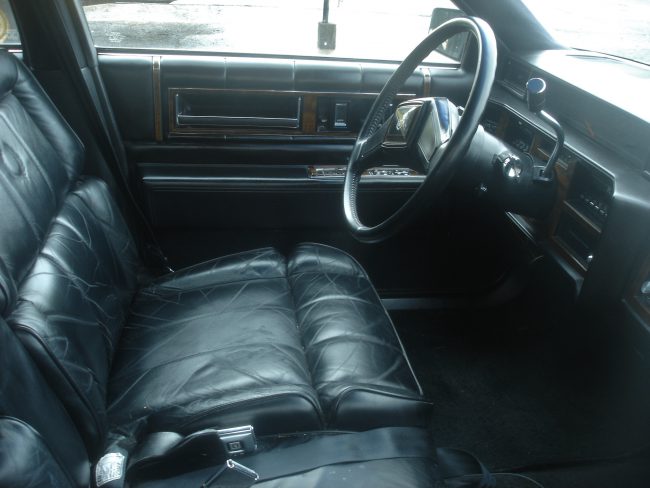
The big news for 1988 was a new engine, the 4.5L V8. This engine finally replaced the star-crossed 4.1 and was much more reliable. Cadillac offered a new six-year, 60,000 mile powertrain warranty to back it up. The 155 hp, 273 CID V8 had digital fuel injection and was mated to a four speed automatic with electronic overdrive.
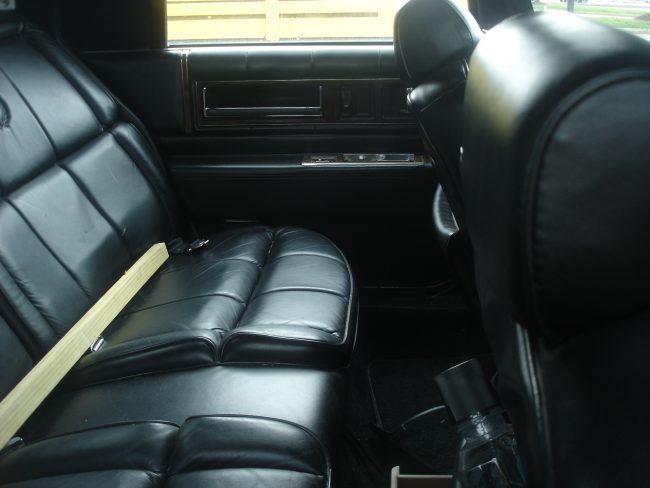
Both Coupe and Sedan de Villes continued to be offered. The full cabriolet roof, first offered in 1987, was still available on Coupe de Villes. It actually did look like a convertible, as long as you were nearsighted enough to not notice the cut lines for the faired-in doors. You could also get a formal cabriolet roof in vinyl with opera lamps on the Coupe, or the standard painted steel roof – probably the least common choice.

1986 Sedan de Ville. Much better without the fake convertible top!
After all, this was a Cadillac, and lots of exterior gingerbread was the order of the day. But our silver example here has one of the then-popular dealer-installed tops. At least it doesn’t have a fake Rolls-Royce grille or Continental kit! I’ve seen these cars with both. They generally look better without the aftermarket rickrack.

Other than the engine, the 1988 models stood pat. Finally, Cadillac had a decent engine in their volume line, although the cars themselves still looked an awful lot like a Volvo 740 with a Brougham package.
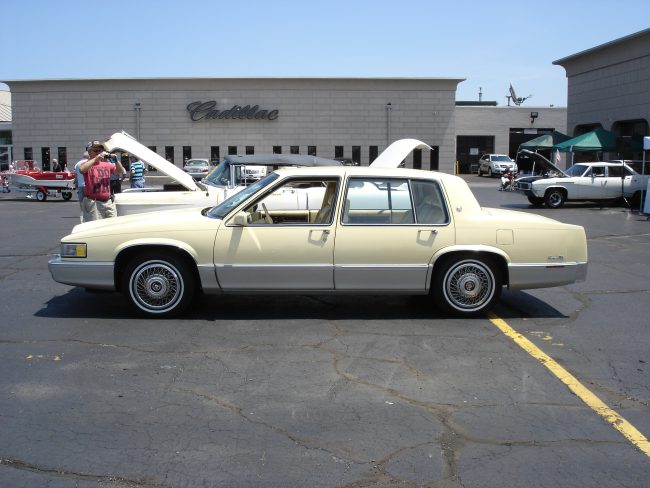
1989 Sedan de Ville at the 2015 Heritage Cadillac show, Lombard, Illinois.
That would change for 1989, when Cadillac finally restored the full size proportions, at least to a certain extent. The 1989s marked Cadillac getting back to what made it great: good looking, good running, comfortable luxury cars.
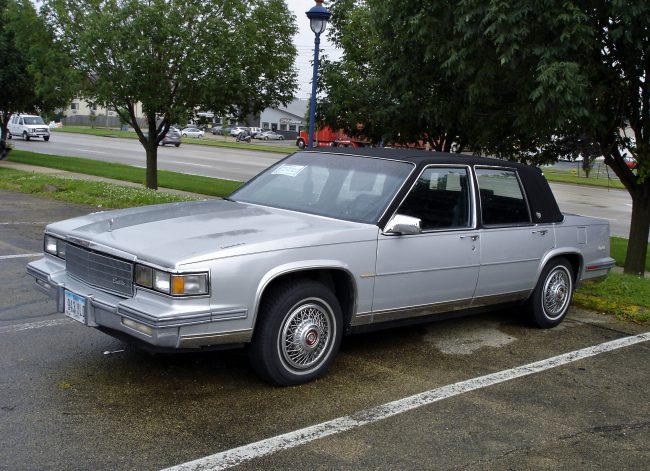
I ran across this ’86 Sedan de Ville in June of 2015, while driving through Clinton, Iowa. It was in nice shape; almost certainly a one-owner car. Even its stand-up hood ornament was present and accounted for.
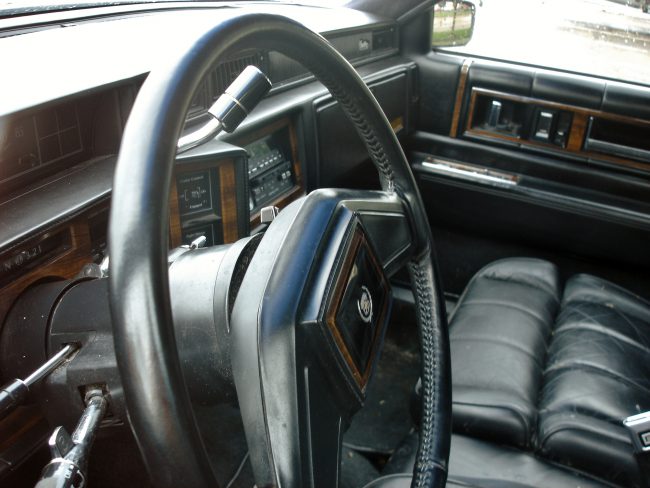
There was no rust and even the black leather bolsters on the driver’s seat were in great shape. I still see these cars from time to time, but they are usually in pretty sorry shape, and usually the later facelifted 1989-93 models.
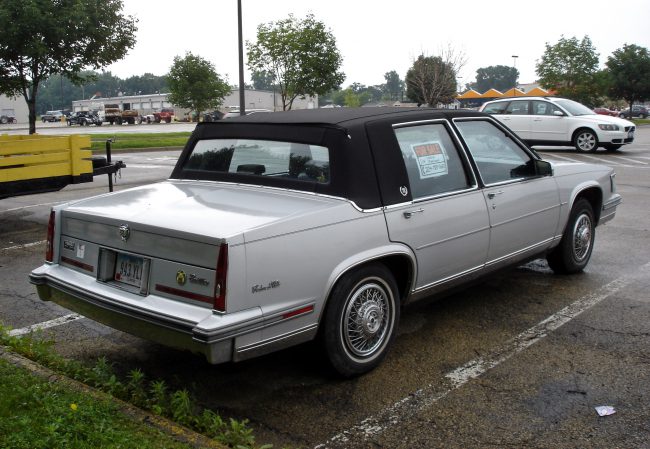
Yes, GM’s top-tier brand stumbled badly in the Eighties, but gradually Cadillac returned to health. The current CTS and CT6, are sharp and readily identifiable (at least, to your author) as Cadillacs. Of course the XT5 crossover is the big seller, but it keeps the sedans in the lineup, and even the XT5 itself is pretty sharp, especially in pearl white. But no matter what shape or form they’re in in the Year of Our Lord 2018, I’m glad you can still get a new Cadillac!
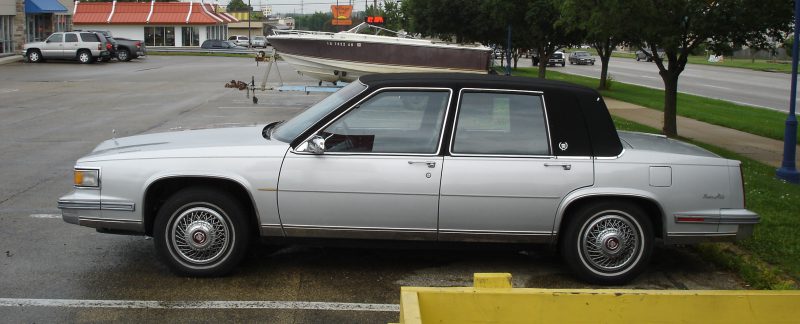

Great story and pictures Tom, but you are way too polite in this particular case. GM management was so incompetent during the late 70s to the 2009 bankruptcy (with certain rare exceptions), it is amazing they avoided bankruptcy as long as they did. Everything was done half-assed, which just didn’t cut it when the Japanese were killing GM on the low/medium end of the market, and the Germans (and later Japanese) were killing them on the high end. If GM management had had some balls, they would have told the EPA to go screw themselves on the CAFE bullshit, and at least kept Cadillac riding on with powerful engines and grandiose dimensions. When you think that GM thought a new pushrod V-8 with 130 hp was “high tech” in 1982 you understand how idiotic they were – I’m sure BMW and Mercedes were shaking in their boots. I wouldn’t be surprised if the styling catastrophes that were the downsized C bodies in 85 (and subsequent stubby Seville and Eldo) weren’t a contributing factor to Bill Mitchell’s early death in 1988. And in the end, what did the ridiculous stubby body and engine dimensions really save on CAFE versus the later elongated bodies and stroked out 4.9 liter engines – why weren’t those the ones introduced originally? If GM had really had some foresight they would have brought out an Escalade in the 1980s with big V-8 power and big in-your-face styling in keeping with dimensional presence of the great Caddies from the 1950s and 60s. Instead GM was led by a bunch of gutless bean counters who gave the ok to the Cimarron and all these other loser Caddies of the 80s.
Large car sales were so in the negative during the 1980-1982 period when the shape of these was being nailed down that it was thought that even looking to “big” would be a negative, you’ve seem to have made your mind up about these, so I’m not here to”bring you to Jesus” on them. but at the same time Cadillac had a 130hp V8 the best the ubermenschen at Mercedes could come up with for the US market was a not all that wonderful 3.8 V8 that made 155hp/196lb-ft of torque, take from that what you will…or wont.
Agree on the premise. The 1980s was where Cadillac gave it up.
I was never a fan of these cars or the marque; but Cadillac was, what Cadillac was. “Was” being the operative word. We were not a Caddy family but a great-uncle, who struck it big in advertising and retired early, always had a Cadillac. He had a 1957 with the huge tailfins, until 1965 or thereabouts…being, as he was, a fan of Harley Earl’s outrageous curves. He passed on the 1959, probably because there was a limit even to his budgets; but his last new car was a 1966 Delta 88. Being an ad-man, he probably sensed the trend was against Cadillacs – and that at his point, the gained status was not worth the additional purchase price.
I always thought the 1977 redesign was well done. Later changes, adding the “formal” roof, looked contrived and clashing…basically, gauche. Never liked them. Downsizing didn’t sit well on traditional three-box car designs; and Cadillac looked as misshapen as most GM cars of that period.
I blame government CAFE standards. Look, let’s face it: Nobody bought a Cadillac for its gas mileage. It was not a concern of buyers; and if it was, there were better choices out there. And Cadillac didn’t understand those customers, and trying to pirate them, led them to disasters like the Cimarron.
Had the CAFE standards been imposed by MANUFACTURER, Chevrolet could have aided in compliance by focusing on small cars – putting quality in their efforts, instead of good-enough-for-who-it’s-good-enough-for, half-fast efforts like the Vega.
But no…by brand. So Badge Engineering would be the norm…if not by body, as with most car lines, than at least by platform.
Who killed Cadillac, as the preemptive luxury brand? GM’s managers held the weapon. But government ministers issued the order, and would not brook refusal.
CAFE played a big role, but GM had the option of just paying a fine for non-compliance and then charging customers a gas guzzler fee, which is what MB, BMW, Ferrari, Jaguar, etc. did with their high powered models. GM had a great brand portfolio, and the best way to manage risk is to make sure your portfolio doesn’t have all its eggs in one basket. Cadillac and Pontiac could have been the “screw CAFE” brands in GM’s portfolio, maintaining the big V-8s and large sized bodies that much of the public wanted, and then positioned Chevy, Buick, and Olds as the CAFE compliance brands. But the GM bean counters wanted all the brands to share the same CAFE compliant bodies, motors, gearboxes, etc., so they could save $5 per unit, and in the process killed brands that WERE worth $billions.
Also, paying the fines when you’re selling 30,000 cars is probably ok, saying “screw you” and paying the fines when you’re selling 300,000 cars probably just means now the government is going to crack down on you even harder.
Yes I’m sure the (Chrysler bailout) Carter or (Japanese Voluntary Restraint) Reagan administrations would have really gone after one of the premier US companies fighting for its life against Japanese competitors for trying to sell profitable gas guzzlers.
Is this the same government that brought 4 or 5 antitrust lawsuits against GM? Yes that one.
What you’re wrote does makes sense, where your wrong is applying “sense” to something involving the government…….
I am not sure Cadillac got enough credit for what was attempted. They really believed that the old ways couldn’t make it through ever tightening CAFE. The failure of the V8/6/4 meant the end of the big block. Imagine MB suddenly having to do a big FWD car that was mid size on the outside with a transverse V8 that nobody was doing at the time. Could they? The unreliability of the early M Class makes me doubt it.
To be forced to go completely out of your wheelhouse and not have it be a mechanical disaster was impressive. Look how much room there is. Notice the still present V8. Neither was there in FWD Continentals for 10 more years and also absent from fwd Imperials.
I bet it was a fight to keep Cadillac exclusive engines and actually come out with a new one. Yes the reputation was hurt by early ones being overmatched in the big RWDs, but it wasn’t like the 3.8 V8 in the Benz was a ball of fire or any more reliable. Some times a large effort should be congratulated and not simplistically sneered at. Thanks Tom for being so even handed.
The problem is GM didn’t have to go FWD on all their cars – BMW, Jag, Mercedes, and (some) Volvo did just fine with RWD and unit body/IRS for roominess. Yes the V8/6/4 might be called a valiant attempt to save the big block, but why did GM invest all the money in cylinder deactivation when they were already working on the replacement 4100? Your comparisons with Lincoln and Chrysler are also telling, because I’m sure that is exactly what GM management was doing at the time – “see we are way ahead of Lincoln and Chrysler”, while they were steadily losing their most affluent customers to MB, BMW, Volvo, Saab, Jaguar and with Acura, Lexus, and Infiniti just around the corner.
Yes the 3.8 liter MB V-8 was also anemic, but it did have 150 hp instead of 130, and MB also offered the 5.6 liter with 225 hp – where was the Cadillac equivalent? The 1st gen. M-class was a disaster in terms of quality, but that was also the period when MB management was following the GM style with a fixation on higher share and bean counting to cut costs, so all MB products of the late 90s to mid oughts were awful. Certainly that is a period that no one current at MB looks back at with nostalgia.
The 4100 was originally to debut with the FWDs. The V8/6/4 was to handle the vestigial Broughams. The MB 3.8 had less torque in a package 300 pounds heavier. The 5.6 came later and solved the timing chain issue of the 3.8 V8. The 4100 also later had 4500s and even 4900s that added back the power while still giving the traditional American torque curve. Never seen in anyone else’s front drives.
The 4.1 beat the mileage of Jags and Dourvan V6 Volvos. While offering more room and at a lower price. It is interesting that so many that deride the FWD Deville’s styling seem to have no problem with the concurrent Volvo 700s, which I also like.
The 4900 was a good engine – it is what Cadillac should have introduced in 1982, but the fact it took them 10 years to punch it out to 4.9 and add port fuel injection speaks to the laziness of GM management, and in typical GM style they get it perfect and then kill after 4 years and replace it with the half-baked Northstar (which also took them 10+ years to get the bugs out).
As for Cadillac being cheaper than Volvos – that was also the problem. Cadillac should not have been trying to outcheap Volvo, they should have been aiming at MB and BMW. Cadillac should have been offering much better cars so they could charge and get MB and BMW prices. GM had Buick and Olds to go after near-luxury Volvo (and Lincoln), but instead they all ended up as cut-rate “luxury” cars.
Import buyers just looked to sneer. That left flyover country, where people like myself are proud skinflints. Cadillac and Lincoln were lucky to get the prices they did. I still don’t see how such a major transition can be lazy…
I don’t think GM had that much money invested in the 8-6-4. That was a joint effort betwee FORD and Eaton Corp; it was originally intended for Ford’s truck line. A two-mode selection – 3/6. Then came CAFE, and someone at Ford thought to put it on a 351 Cleveland as a demonstration project. Popular Science reviewed it…instead of two modes, four cylinders would deactivate, in steps. 4-5-6-7-8.
Ford dropped it – wisely, as it turned out. Instead, Eaton took it to GM, or GM bought the rights from Eaton. Don’t know which; but whatever they paid for it was money flushed.
But it probably wasn’t so much or involving so much time as if they’d hatched it themselves.
Cadillac kept using the 4-6-8 system on the Fleetwood 75 limousines through 1984, so they got some of their moneys worth for the few thousand limos a year that were made with the 4-6-8 after 1981. From what I’ve read, after the first year, there were several fixes that were pushed through that made it much more reliable, most post 81 4-6-8 Cadillacs were fairly trouble free.
Great write-up as always, Tom. I’ve always felt that these downsized Cadillacs never got the proper recognition they deserved. General Motors was always great at building large rear wheel drive automobiles so it must have been a daunting task to totally change their luxury car division. I give them credit for being the first American luxury car company to really attempt downsizing. People bought Cadillacs because of their presence, prestige and luxury. These downsized front wheel drive Cadillacs were a shock to the American public. If only Cadillac had designed a great smaller V-8 engine with the durability of the 425 or the 350 or even the 3.8 V6 in these cars the reliability would have been outstanding and possibly the reputation of these cars would also have been great. They drove extremely well, were very roomy and comfortable and were extremely easy to handle in comparison to the older rear wheel drive models. I know first-hand because my grandmother had a 1979 Sedan DeVille that she rarely drove because it was so large and hard for her to handle. One day I saw a 1987 Fleetwood d’Elegance at our local Cadillac dealer. They let me take the car to her and instantly she fell in love with it. I can still remember her doing a u-turn in the local pharmacy parking lot, saying how easy this car handles. She loved that car, and often got comments on how nice it was. So there are some happy stories surrounding these downsized Cadillacs.
lol Volvo 740 with a brougham package. I never noticed that before but it’s true
Pingback: 1990 Cadillac Brougham - Now THAT'S Cadillac Style! - Riverside Green